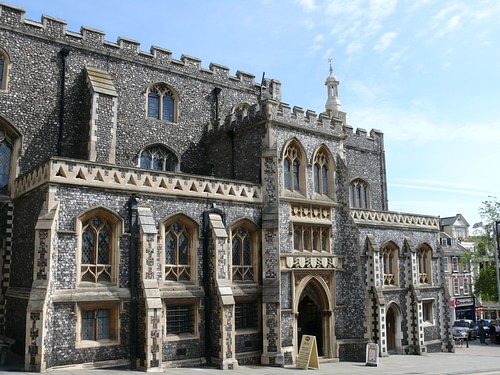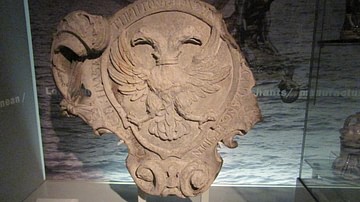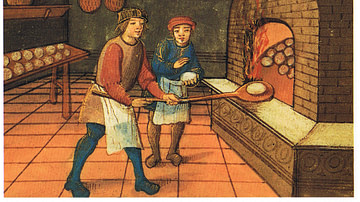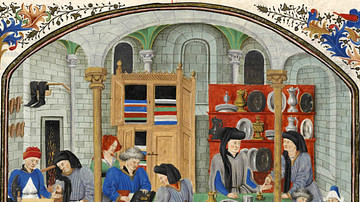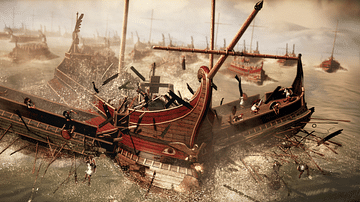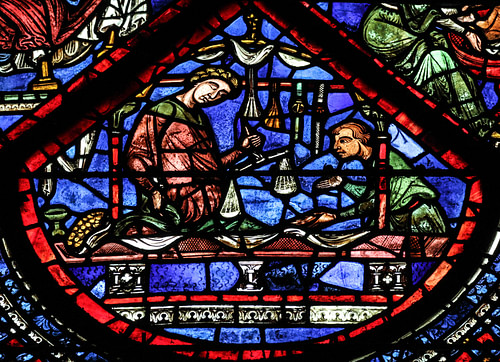
Guilds of merchants and craft workers were formed in medieval Europe so that their members could benefit from mutual aid. Guilds ensured production standards were maintained and that competition was reduced. In addition, by members acting collectively, guilds achieved political influence. There were two main types of guilds: merchant guilds for traders and craft guilds for skilled artisans.
Entry requirements to guilds became stricter over time as those who controlled the guilds became part of a richer middle class and set a higher membership fee for outsiders. This new bourgeoisie successfully sought to maintain their position above workers without the means or skills needed to run their own small businesses.
Name & Origins
The name 'guild' derives from the Saxon word gilden, meaning 'to pay' or 'yield', as members of the guild were expected to contribute to its collective finances. In the 11th century, early guilds functioned in towns much like village communities did in rural areas with the additional factor that merchants required more extensive protection for themselves and their goods as they travelled along trade routes at home and abroad. From the 12th century guilds were organised according to types of merchants and professionals like doctors before the idea expanded to include skilled artisans. Accordingly, there were over 100 guilds in Britain, for example, representing first merchants and traders, and then any skilled craft industry from weaving to metalworkers. Italy was another country where guilds were popular; the city of Florence alone boasted 21 guilds in the mid-14th century and the clothmakers guild there controlled some 30,000 workers. Flanders, France (Paris alone had 120 guilds) and Germany were other places where guilds rose to prominence.
What Were Merchant Guilds?
Security was a great concern for medieval traders who worried that their goods could be stolen in transit or while in storage. Mutual protection and travelling in groups thus offered the best solution in a period when state intervention was sporadic or non-existent in certain regions. The right to form a guild in England was often given by the crown as part of a town's charter of freedom. A charter of freedom involved the sovereign selling the charter which, when given, waived the obligation of a town's inhabitants to pay feudal duties. Instead, they could apply their own taxes to the traffic of goods through the town. Merchant guilds did give back to their communities, too, prescribing from their members charitable gifts of food, wine and money for the clergy and poor and needy. The political class of a town typically came from the merchant guilds and, with a charter also establishing local courts, a new and powerful middle class sprang up. A similar pattern of development had occurred and was ongoing in other European countries.
What Were Craft Guilds?
From the 12th century in France and Italy, 'craft' guilds began to form which were associations of master workers in craft industries. Cities like Milan, Florence and Toulouse had such guilds for food producers and leather workers. Some of the earliest craft guilds in England were guilds of weavers, especially in London and Oxford. Other craft guilds eventually included associations of cutlers (makers of cutlery), haberdashers (dealers in goods needed for sewing and weaving), dyers, bakers, saddlers, masons, specialists in metal goods such as blacksmiths, armourers, locksmiths and jewellers, and many others covering all aspects of daily life. Some guilds were based on the materials their members worked with rather than the end product so that, in France, for example, there were separate guilds for makers of buckles depending on whether they used brass or copper. So, too, guilds of the makers of prayer beads were distinguished by which material they used to make their beads, whether it be bone, amber, jet or whatever. Each guild was managed by a small group of individuals known as guildmasters who were assisted by a body of jurors whenever there were disputes amongst members.
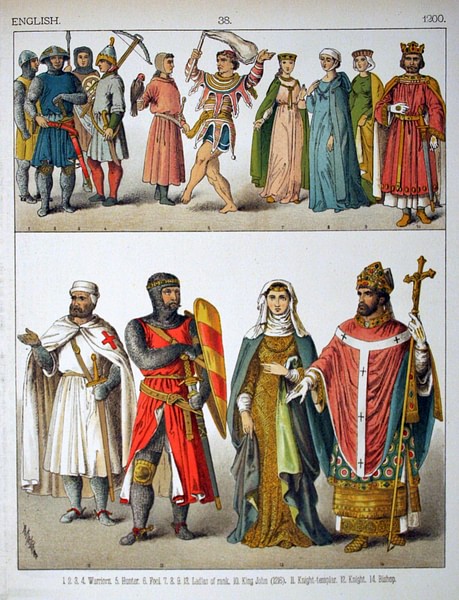
As this class of skilled workers with their own businesses became ever richer so the entry into a guild became more difficult as those with privileges sought to keep out those without them. On the other hand, there was another reason to limit entry: to maintain the high standards of skill of a particular profession. For this reason, many guilds insisted on an entrance fee which went towards the apprenticeship of the new member but also paid for the maintenance of the meeting place of members, the Guildhall, administrative costs, and health services for members if and when required. In addition, the guilds could organise festivals and pay funeral costs for its members or give financial aid to the widows and orphans of deceased members.
Craft guilds were, as noted, particularly keen to make sure their members' products were of a high enough quality and the weights, dimensions and materials or ingredients of goods all met the current industry standards. Even such workers as bakers could face random checks on their bread by the guildmasters and jurors, as this extract on Parisian bakers illustrates:
If the master determines that the bread is not adequate, he can confiscate all the rest of it, even that which is in the oven. and if there are several types of bread in a window, the master will have each one assessed. And those which are found to be too small, the master and jurors will have them donated to charity. (Reglemens, quoted in Singman, 233)
Quality was further maintained by regulating apprenticeships which had to be of a minimum duration and with a master who had proven skills at their craft. After several years of training apprentices then worked for a master. To become a master one had to present a 'masterpiece' to the guild's hierarchy which showed that the worker had acquired the necessary skills in their particular craft. There was also a financial burden as the title of master was only given to those able to fund their own workshop, tools and a celebratory banquet.
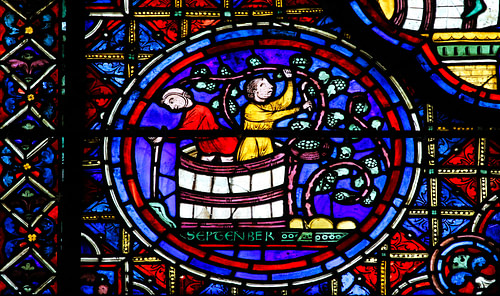
The advantage to guild members of all these rules, besides maintaining public confidence in their products, was that they could control competition and be exempt from local taxes, although a producer could not undercut the prices of fellow guild members. Additional rules that protected members from each other included not poaching a customer from another member's shop or criticising the produce of a fellow member (this was especially relevant to cooks), not working on religious holidays or, in some cases, not working after dark.
Other parts of the industry that a guild controlled included wages and the conditions of sale of the product. In effect, then, a guild established a monopoly on all aspects of a particular craft and their control of wages was especially significant when labour became short under such conditions as plagues or famines. Under normal circumstances, a labour shortage would mean a rise in wages for labourers but the guilds often ensured this did not happen (and so make their goods more expensive to sell). Ordinary workers were even prohibited from forming their own associations and this sometimes led to riots and revolts, particularly violent ones breaking out repeatedly in Flanders and Florence, for example, in the 14th century.
The Effects of Guilds on Society & Women
Guilds, especially the merchant guilds, helped produce a rich middle class in medieval society as merchants prospered and began to buy what has always been regarded as a badge of the aristocratic elite: land and property. These nouveaux riches may not have been fully accepted into high society but they themselves began to carve out their own unique place in the social order by distancing themselves from everyone below them. Many guilds, even craft guilds, only accepted new members if they were the sons of existing ones or if one could gain the sponsorship of a master who would take them on as an apprentice. Masters were often biased towards relatives and membership fees were higher for those outside the community so that many guilds, in effect, produced hereditary professions. Further, by stipulating that masters owned their own means of production in the form of their workshop and tools, guilds thus created a permanent class divide between owners and labourers.
As guilds made the rules and decided the wages it became difficult for ordinary workers to protect their rights and own interests. Strikes by textile labourers in the city of Ghent in 1274, for example, resulted in business owners agreeing with those in neighbouring towns not to give work to strikers. However, it is important to remember that in medieval societies there was less of a conflict between wealth and labour than there was between rival industries and towns. In this sense, guilds may well have actually helped make medieval society, at least in larger towns, more cohesive and stable. Finally, one aspect of society which sprang from educational guilds and helped, at least eventually, to allow some people a means to climb the social ladder, was the 22 universities of medieval western Europe.
One section of society that was treated unequally by guilds was women. There were almost no specific guilds for women and the institutions were always dominated by men (there were a few exceptions such as the women's silk guilds in Paris and the gold spinners of Genoa). Even a profession dominated by women such as midwives did not have their own guild but belonged to that of the surgeons. Women, although they did frequently work alongside men in such industries as spinning, metal polishing and food preparation, only very rarely achieved master status and some guilds such as the pepperers, drapers and (eventually) brewers banned women from becoming apprentices. Legally, women were usually under a male relative's guardianship or their husband's. Only if a woman's fellow-guild member husband died could she enjoy some freedom. A widow could carry on a deceased master's business, for example, and have the full rights of guild membership if she had once worked alongside her husband and she did not remarry.
The Evolution of Guilds: Local Government
In London, the wealthiest craft guilds, known as the livery companies, became very powerful political players in the city. Indeed, in many towns across medieval Europe, it became almost impossible to build a political career if one was not a member of a guild. The livery companies of London eventually morphed into major financial institutions. Across the waters in Paris, water merchants monopolised trade on the River Seine and had authority over such matters as petty crimes and the city's quotas of salt and grain. In 1260, four of the jurors of the water merchants guild were appointed as city magistrates. In 13th-century Germany several guilds, including ones from different towns, got together and formed an organisation known as the Hanse. These Hanse would then join and form the Hanseatic League of almost 200 trading cities by the middle of the next century. In contemporary Florence, the main guilds were permanently represented on the city council.
Eventually, then, and across Europe, many guilds and functions of local government became inseparable as the wealthier middle class began to take some political power from the ruling aristocracy. Lower down the social ladder, the craft guilds permitted skilled craftworkers to protect their own industry and provide mutual social aid while at the bottom, the unskilled workers continued, as always, their fight for uncertain and seasonal employment which often involved moving to wherever such work could be found.
